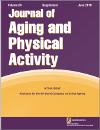Exergames to Improve Postural Balance in Older People with Dementia
| Author | Majed, Lina |
| Author | Hansen, Clint |
| Available date | 2017-02-07T08:03:28Z |
| Publication Date | 2016-06 |
| Publication Name | Journal of Aging and Physical Activity, Supplement |
| Identifier | http://dx.doi.org/10.1123/japa.24.s1.s4 |
| Citation | Lina Majed, Clint Hansen “Exergames to Improve Postural Balance in Older People with Dementia” Journal of Aging and Physical Activity, the 9th World Congress on Active Ageing June 28-30, volume 24, issue s1 |
| ISSN | 1063-8652 |
| Abstract | The focus of the study concerns the well-documented increased risk of falling in older adults that can lead sometimes to fatal consequences. Improving posture and motor skills is central to preventing falls. Further investigations targeting specific older people such as those suffering from cognitive impairment or dementia are still needed for fall prevention (Shaw, 2003). New technology-based methods, such as digital motion-sensitive games or exergames, appear promising for improving balance (Lamoth, Stins, Pont, Kerckhoff, & Beek, 2008; Lamoth, Caljouw, & Postema, 2011). The present pilot study was aimed to analyze the feasibility and effectiveness of digital balance exergame training in elderly people with dementia. Methods: The postural sway is a common measurement when evaluating the standing posture stability of a person. This study was conducted with four subjects (88.8 ± 6.4 years) suffering from dementia and living in a retirement home. The participants completed a six-week (two sessions per week of 60 minutes) training program using the Wii Fit system (Nintendo). Pre- and post-tests were done to collect the center of pressure (CoP) fluctuations using a force plate (Kistler Type 9260a). The posturographic analyses included the standard deviation in the anterior-posterior (A/P) and medio-lateral (M/L) directions, the mean velocity, the path lengths, and the 95% confidence ellipse. Nonparametric Kruskal-Wallis test (Statsoft, Statistica) was used to examine the effects of training on the selected parameters with a significance level of p < .05. Results: Although the six-week intervention did not bring significant changes to the tested parameters, clear trends were identified. Results showed an increase of 12.48% in the mean CoP velocity, an improvement of 18.89% for the 95% confidence ellipse and a clear extension of the CoP path. Conclusion: Even though no significant pre–post changes were noted, a trend toward better stability was shown and considered a promising result. Exergames could offer a safe and motivating option to improve postural parameters in older people with dementia. However, further investigations with a larger sample would be needed to bring further insights on the effectiveness of this method. |
| Language | en |
| Publisher | Human Kinetics, Inc. |
| Subject | Exergames Postural Balance Older Adults Dementia |
| Type | Conference Paper |
| Issue Number | S1 |
| Volume Number | 24 |
| ESSN | 1543-267X |
Files in this item
This item appears in the following Collection(s)
-
Sport Sciences [181 items ]


